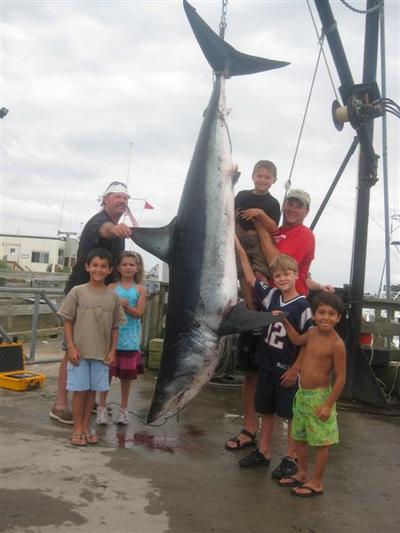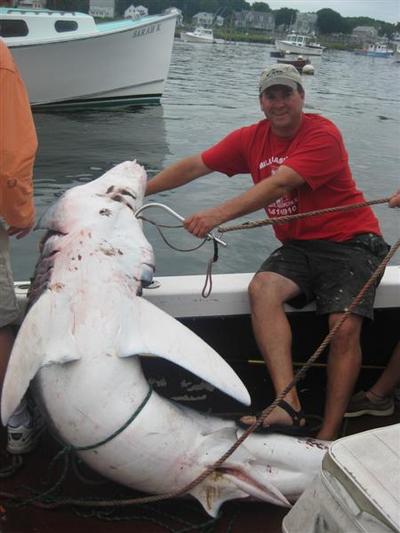Shark Fishing
Here it is, one of my favorite most exciting things on the planet to do. How? Well, it's not rocket science, but it can be dangerous if you don't pay attention.
One thing I like to point out is that 90% of the sharks that we catch in Massachusetts are blue sharks. We don't eat blue sharks, so it's a catch-and-release effort. It is, however, the largest fish that most people are ever going to catch, so I love it. I love seeing the power that these fish can exert on a fisherman. Plus, we've caught 500 pound fish that were truly giants. Amazing fish.
Catch and Release...First, we use circle hooks when shark fishing. The hooks that I have are Mustad Duratin 16/0 circle hooks. They're large, but designed to hook the shark in the side of the jaw. They do it very well. Most sharks, when hooked there, are going to stay hooked. The key to hooking a shark in the jaw, in my mind is this. PAY ATTENTION. Why? If you don't, the shark could grab your bait and swim around swallowing and getting your bait into it's stomach before you know that something is happening. Much of this watching is done by myself and my mate, but it's nice too if you're watching. That's a blast. I don't like to "wait and wait and wait" for the shark to swallow the bait and get it all into their mouth. I've watched enough sharks from the roof of my boat and seen what they do when they grab a bait to know that they have big mouths. They don't nibble. They open their mouth wide and suck the whole thing in. At this time they start looking for more bait.
When I see action on a bobber, I instruct the fisherman to grab the rod and get it into the harness and into the fighting belt. The rod is tethered to the boat and most times so is the customer. I'm a big fan of the safety line. Just in case. Just in case you lose your balance. Just in case the shark takes a big run straight down and you are right along the gunnel. You could get hoisted right over the side. If the bobber is moving or underwater, the lever drag reel is engaged to 'strike' and I instuct the customer to reel steadily. When the line becomes tight, with the rod pointed at the fish, I tell them to reel 4 or 5 times very quickly until the line gets even more taught, then I have them set the hook once really hard. Then reel the line even tighter (about 3 more cranks), then another serious hookset. This is just to make sure that the barb is buried and the line is tight. We use mono for sharks, which tends to stretch. If there is a lot of line out, I will set the hook a third time as more line means more stretch.
Once hooked, that shark will make an initial run. Sometimes it's a crazy run and sometimes it's not much as the fish really doesn't know what's going on. In that case, it's very possible to get the shark to the boat quickly, but don't think it's over. When the shark sees the boat they usually go ape. Keeping your balance is key. If it's a big fish, we start the boat up and get the other lines in asap. Even blue sharks will run 200+ yards against all of the drag a 50 wide has to offer. We've had blue sharks almost spool us (500+ yards). Don't be lulled. And forget about makos...Seeing a big shark like that jump out of the water is amazing. We've gotten wet before as they've jumped that close to the boat! Yes, they are also one of the fastest, strongest fish in the sea! If your line goes slack at any time, point the rod at the "fish" and reel fast, as the shark may be heading back towards the boat.
BAITS AND PREPARATION FOR SHARK FISHING
Chum. Chum. And more chum. Also fish oil and blood. I don't like to move around when shark fishing. It's my belief that the fish WILL FIND you if you're in a good area. If not, that's fishing. So, find a good area for whatever reason--I like structure more than anything else where I fish--if you're in the right area, there'll be bait there because of the structure and the sharks will be monitoring that situation. Chum them up and you'll find them. Or they'll find you. One exception to this rule is the draggers south of Martha's Vineyard... Find them and be nimble enough to move near them so that you can set up and have them pass you by--the sharks will follow those draggers around and will detour to you. They will outchum you anyday and the sharks know it by now.
About setting up a chumslick...figure out where you want to fish--I like an area where a 4+ mile drift is possible because there is a day's drift, for the most part. First, stop the boat for about 10 minutes and see your direction and speed. If the drift is slow, head into the drift about an extra mile or so---then power chum for a mile at about 3-4 mph. You are kick-starting your chum slick for that mile. During that power drift, I like to have two buckets of chum going, one on each rear corner. I also like to be dripping fish oil. The oil floats, which does a couple of things. First, it shows you your drift history. And second, it calms down the water near the boat so you can see more clearly though the water (and see cruising sharks by the boat).
Setting the lines around the boat. We typically run 4 lines when shark fishing. We spread them out in the water column and back into the slick. The first line that we put out is the "straight down and close". We don't use a float, but have our weight (a medicine bottle filled with bb's that rattle when the boat rocks). We'll typically use a butterflied mackerel for this bait. The second line that we set out is the "far away and deep". We'll typically send this one down 150+ feet down with a glow skirt and a large bluefish fillet/mackerel sandwich. We then set out our "pretty far away and near the surface". This bait may be a butterflied bluefish or whole bluefish fillet (split-tailed). The 4th bait is going to be about 75' away from the boat and down 50-70'. We use a variety of baits here, such as a large local squid/Mario's giant squid strip, a mackerel/bluefish sandwich, or a whole mackerel with a bright skirt.
WHEN THE SHARK GETS CLOSE TO THE BOAT
Here is time to listen and everyone must know what their role is. I am a huge fan of wind-on leaders. We use 300# leaders that are about 20 feet long. We then have a heavy-duty swivel connected to 6' or so of single-stand wire. In this manner, you can reel right up to the point where the leader-man grabs the line without having any slack in the line. It is very important to keep any slack out of the line in case the shark takes a hard run at the boat. If there is any slack, it's very possible that the line will wrap around the rod or a person. That could be deadly, if not totally destructive. We used to use a 2-part leader and/or a longer wire, but I don't like having the leader-man deal with any loops of line around the boat with an angry shark on the other end of the line.
Their power at the boat is NEVER TO BE UNDERESTIMATED. Once the leader-man grabs the leader, we like to have the fisherman lessen the drag a bit in case the shark pulls the line free. In this case, there isn't a ton of pressure on the fish because sometimes it takes a split second for the drag to 'kick in' and the line may snap. With more line out, the line will stretch a bit as the drag starts. Matt Merrick has found that if he can keep the shark's head above it's tail, he can control it very well. Once the head starts pointing down or the shark gets it tail up above it's head, it's wise to release the line smoothly and just reel the shark back to the boat again. Seeing Matt almost hoist a 400 pound blue shark vertical in the water, I know this to be true.
Because we use circle hooks and most of our sharks are hooked in the corner of the jaw, we try to remove the hook from the shark's mouth as a clean release. We use an ARC dehooker, and we give it a good effort to pop the hook out.
FOR SHARKS WE'RE GOING TO KEEP This is what it's all about, right? Catching something that you can eat. For starters, if we have to measure it, we're not going to keep it. That's a pretty fair rule. The sharks only have to be 54" long, which is not a very large shark. It's also a great feeling releasing a keeper shark. For sharks, makos are great eating. Porbeagle sharks are very similar. The thresher also makes it to the dinner table. The dusky used to make it there, but it's not allowed anymore. Since the sandbar shark is so similar to the dusky in appearance, it gets to swim away, though it's a good-eating shark as well. Blue sharks are not to be eaten as "everyone says they're not edible".
So, what do we do when it comes time to land a shark? First, we clear the boat of all clutter. We pull all other lines from the water and store the rods inside the cabin or tight up against it. Get gloves on anyone and everyone who may be handling lines, harpoons, or flying gaff. We start the engine and position the boat to keep the fish off of the stern quarter. We can then fight the fish properly. With the harpoon ready and the flying gaff ready and the straight gaff ready and two tailropes ready...There's a lot to do. Our first choice is to hit the shark with the harpoon, buttonhooking the shark if possible right behind the dorsal fin. That is to say, we want to drive the harpoon shaft right through the shark. Keep that dart as sharp as possible, and then some. Hit it with a file before every trip and hit the shark hard. We hit it behind the dorsal fin because I don't want to pull the shark head-first towards the boat--one good swing of the tail and it could be jumping into the boat. Ouch.
We get the harpoon into the fish and control the fish with the harpoon line. We then like to bury the flying gaff into the shark's gills, wherein we can stretch the shark out nicely and use the straight gaff to the tail in order to get a tailrope on the shark. Once the shark is tailroped to the boat, it's officially yours unless your cleat rips off your boat! Just be careful and assume that the shark doesn't die for a while.
I like dragging the shark backwards for a while, all the while jabbing it the gills to bleed it out as much as possible. When do I like bringing the shark onboard? Well, I'm never comfortable doing this, but it does have to be done realistically. Just keep it's head away from you as much as possible and be ready to get a cooler between the head and the customers!!



